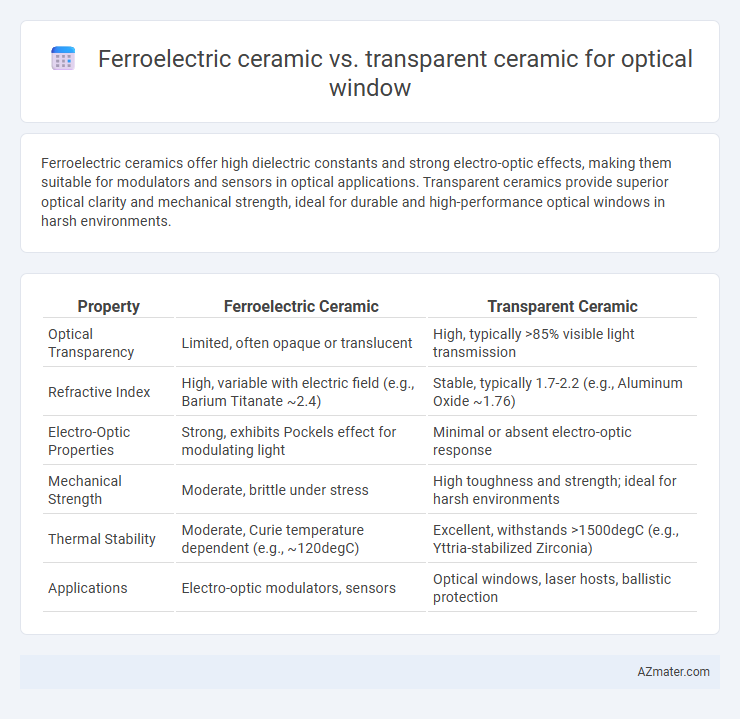Ferroelectric ceramics offer high dielectric constants and strong electro-optic effects, making them suitable for modulators and sensors in optical applications. Transparent ceramics provide superior optical clarity and mechanical strength, ideal for durable and high-performance optical windows in harsh environments.
Table of Comparison
| Property | Ferroelectric Ceramic | Transparent Ceramic |
|---|---|---|
| Optical Transparency | Limited, often opaque or translucent | High, typically >85% visible light transmission |
| Refractive Index | High, variable with electric field (e.g., Barium Titanate ~2.4) | Stable, typically 1.7-2.2 (e.g., Aluminum Oxide ~1.76) |
| Electro-Optic Properties | Strong, exhibits Pockels effect for modulating light | Minimal or absent electro-optic response |
| Mechanical Strength | Moderate, brittle under stress | High toughness and strength; ideal for harsh environments |
| Thermal Stability | Moderate, Curie temperature dependent (e.g., ~120degC) | Excellent, withstands >1500degC (e.g., Yttria-stabilized Zirconia) |
| Applications | Electro-optic modulators, sensors | Optical windows, laser hosts, ballistic protection |
Introduction to Optical Window Materials
Optical window materials must exhibit high transparency, mechanical strength, and environmental stability to ensure clear and reliable signal transmission. Ferroelectric ceramics, such as barium titanate, offer tunable dielectric properties and strong electro-optic effects but often suffer from limited optical transparency in the visible to near-infrared range. Transparent ceramics like alumina (Al2O3) and yttria-stabilized zirconia (YSZ) provide excellent optical clarity, high fracture toughness, and broad spectral transmission, making them ideal for advanced optical window applications.
Overview of Ferroelectric Ceramics
Ferroelectric ceramics such as barium titanate and lead zirconate titanate exhibit spontaneous polarization that can be reversed by an external electric field, making them valuable in sensing and actuation applications. Their high dielectric constants and nonlinear optical properties enable tunable optical windows with fast response times, but their optical transparency is generally limited to specific wavelength ranges due to scattering and absorption. In contrast, transparent ceramics like alumina and spinel offer superior optical clarity and mechanical strength, making them more suitable for broadband optical windows requiring high durability.
Overview of Transparent Ceramics
Transparent ceramics for optical windows offer superior mechanical strength, high thermal stability, and excellent optical clarity compared to ferroelectric ceramics. These materials, such as alumina and spinel, provide enhanced transparency over a wide spectral range and superior resistance to laser-induced damage, making them ideal for high-performance optical applications. Their microstructure is engineered to minimize light scattering and maximize transmittance, ensuring consistent optical quality under extreme environmental conditions.
Key Properties of Ferroelectric Ceramics in Optical Applications
Ferroelectric ceramics exhibit high dielectric constants, strong electro-optic effects, and rapid response times, making them ideal for modulating light in optical windows. Their spontaneous polarization enables tunable refractive indices, enhancing performance in photonic devices and adaptive optics. In contrast to transparent ceramics, ferroelectric variants offer unique polarization-driven optical nonlinearity crucial for signal processing and sensing applications.
Key Properties of Transparent Ceramics in Optical Applications
Transparent ceramics exhibit high optical clarity, exceptional mechanical strength, and superior thermal stability, making them ideal for demanding optical window applications. Unlike ferroelectric ceramics, transparent ceramics offer low light scattering and high transmittance in visible to infrared wavelengths, enhancing image quality and signal transmission. Their resistance to abrasion, chemical corrosion, and thermal shock ensures durability and reliability in harsh environments.
Optical Performance Comparison: Transparency & Refractive Index
Ferroelectric ceramics typically exhibit high dielectric constants but lower optical transparency, often limiting their use in optical windows where clarity is critical. Transparent ceramics, such as yttria-stabilized zirconia or aluminum oxynitride, achieve superior optical transparency with transmittance exceeding 85% in the visible to infrared range and maintain a consistent refractive index around 1.9 to 2.2, optimizing light transmission and reducing scattering. The refractive index of ferroelectric ceramics generally varies more with wavelength and temperature, causing potential optical distortions, whereas transparent ceramics provide stable and uniform refractive indices essential for high-precision optical applications.
Mechanical Strength and Durability Analysis
Ferroelectric ceramics offer high mechanical strength due to their dense microstructure and intrinsic piezoelectric properties, enhancing durability under stress for optical window applications. Transparent ceramics, such as alumina or spinel, combine exceptional hardness and fracture toughness with excellent optical clarity, providing superior resistance to impact and environmental degradation. Mechanical strength in transparent ceramics typically surpasses that of ferroelectric ceramics, making them more suitable for harsh operational environments requiring long-term durability.
Thermal Stability and Environmental Resistance
Ferroelectric ceramics exhibit moderate thermal stability with Curie temperatures typically ranging from 100degC to 200degC, limiting their performance in high-temperature optical window applications. Transparent ceramics, such as aluminum oxynitride (ALON) and spinel, offer superior thermal stability, often exceeding 1200degC, making them ideal for harsh environments. Their enhanced environmental resistance includes excellent chemical inertness, high hardness, and resistance to moisture and corrosion, surpassing ferroelectric ceramics in maintaining optical clarity under extreme thermal and environmental conditions.
Cost, Scalability, and Processability
Ferroelectric ceramics typically offer lower cost and simpler processability compared to transparent ceramics due to established fabrication techniques and readily available materials, making them viable for large-scale production. Transparent ceramics provide superior optical clarity and mechanical robustness but involve complex, high-temperature sintering processes that increase manufacturing costs and limit scalability. Selecting between ferroelectric and transparent ceramics for optical windows depends on balancing budget constraints, production volume, and the required optical performance.
Conclusion: Choosing the Ideal Ceramic for Optical Windows
Ferroelectric ceramics offer excellent electro-optic properties and high dielectric constants, making them ideal for modulators and tunable optical windows where active control is required. Transparent ceramics provide superior mechanical strength, durability, and optical clarity across a broad spectrum, making them optimal for protective windows and lenses in harsh environments. The ideal choice depends on the application's need for either active electro-optic functionality or passive durability and transparency.

Infographic: Ferroelectric ceramic vs Transparent ceramic for Optical window
 azmater.com
azmater.com